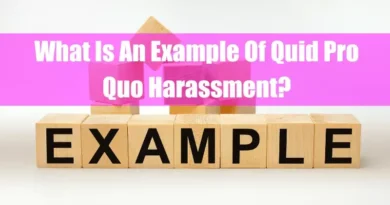Explaining Gaslighting and Quid Pro Quo Relationship
Takeaways
| Key Point | Description |
|---|---|
| Toxic Dynamics | Gaslighting and quid pro quo harassment create a toxic environment where individuals are manipulated into doubting their experiences while facing coercive demands tied to professional or personal advancement. |
| Perpetrators’ Tactics | Perpetrators deny inappropriate behavior, shift blame, silence emotions, recruit others to reinforce their narrative, and foster fear, entrapping victims in confusion and submission. |
| Psychological Impact | Red flags include diminished confidence, social isolation, and cognitive distress, signaling the erosion of the victim’s autonomy and trust in their judgment. |
| Real-World Examples | Examples reveal the nuanced interplay of gaslighting and quid pro quo harassment, showing how perpetrators exploit ambiguity to maintain control while victims grapple with self-doubt and societal pressures. |
Introduction
Gaslighting and quid pro quo harassment are manipulative tactics that distort reality for personal gain. Gaslighting causes individuals to question their own perceptions, while quid pro quo harassment leverages career opportunities in exchange for unwelcome favors. Together, they create a toxic environment that leaves victims feeling powerless and professionally vulnerable.
The consequences extend beyond the workplace, often leading to anxiety, depression, and PTSD. Many suffer in silence, uncertain of how to respond. Recognizing these behaviors and fostering a culture of accountability is essential to breaking this cycle and ensuring a safe, respectful environment for all.

Tactics, Red Flags, and Power Plays in Gaslighting and Quid Pro Quo Harassment
Imagine an individual seeking a favor from you, such as a promotion or avoiding consequences. They present it as an incentive while employing manipulative tactics to influence your decisions. However, a more insidious aspect is that they distort your perception of reality, causing you to doubt your own senses and judgment. This is the essence of Gaslighting and Quid Pro Quo Harassment. Let’s examine the strategies used and how to recognize them.
A. The Perpetrator’s Playbook:
- The Memory Eraser: “Did that even happen?” they say, wiping their hands clean of any wrongdoing. They might deny saying those creepy things, claim your discomfort was a misunderstanding, or even blame you for being “sensitive.” Suddenly, you’re questioning your own memory, wondering if you imagined it all.
- The Blame Game: It’s never their fault, oh no! They flip the script, making you the bad guy. Maybe you “misinterpreted” their intentions, “overreacted” to a joke, or even “provoked” them with your “attitude.” Now, you’re feeling guilty and confused, second-guessing your emotions.
- The Feeling Silencer: “Don’t be silly; that’s nothing to be upset about.” They brush off your feelings like crumbs off a tablecloth. Your anxieties? “Just overthinking.” Your discomfort? “All in your head.” By dismissing your emotions, they make you doubt your own judgment, silencing your inner voice.
- The Whispering Chorus: Sometimes, the gaslighting spreads. They recruit friends, colleagues, or even family to echo their twisted story, making you feel isolated and surrounded by doubt. It’s like a chorus of voices repeating, “It’s all in your head,” drowning out your own truth.
- The Fearmonger: They create an atmosphere of unease, where shadows lurk, and threats hang heavy. They may hint at the consequences of speaking up, whisper rumors about your job being on the line, or build an environment of constant surveillance. Fear becomes your prison, keeping you trapped in their twisted game.

B. Red Flags: When the Dance Turns Dark:
- The U-Turn in You: Are you noticing changes in your behavior? Feeling less confident, questioning your decisions, or needing help to trust your gut? These are signs that gaslighting is taking its toll, chipping away at your self-worth and judgment.
- The Erosion of Trust: Do you isolate yourself, withdraw from loved ones, or lean heavily on the perpetrator for support? This emotional dependence can be a symptom of the manipulation, blurring the lines between trust and control.
- The Mind Maze: Foggy thinking, trouble concentrating, and difficulty making even simple decisions can be signs of mental distress caused by gaslighting. The constant questioning and confusion take a toll on your cognitive abilities.
- The Lonely Cage: Are you feeling isolated, disconnected from friends and family, or even fearing speaking up to anyone? This social isolation is often a deliberate tactic used by the perpetrator to keep you under their control.
C. The Power Play: Why They Dance This Way:
- Figures of Authority: Often, the perpetrator holds a position of power over you, like a boss, supervisor, or even a teacher. This hierarchical dynamic gives them leverage, making the quid pro quo threats and intimidation all the more potent.
- The Carrot and the Stick: They dangle rewards like promotions or approval, then threaten them away if you don’t comply. This keeps you trapped in a twisted game of cat and mouse, always chasing the carrot while fearing the stick.
- The Cycle of Silence: Gaslighting thrives in silence. The fear of consequences, the erosion of trust, and the isolation all work together to keep the victim quiet. This silence perpetuates the cycle of abuse, giving the perpetrator free rein to continue their manipulative dance.
Resisting Gaslighting in Quid Pro Quo Harassment
When you’re caught in the dance of Gaslighting and Quid Pro Quo Harassment, finding your way out can feel impossible. The shadows twist your reality, the power imbalance suffocates, and the silence seems deafening. But remember, even in the darkest corners, there are tools to reclaim your light and rewrite your story. Here are some strategies to resist the manipulation and step back into the empowering sunshine:
A. Trusting Your Inner Compass:
- Validate Your Feelings: Don’t let anyone gaslight you out of your own emotions. Trust that gut feeling if something feels wrong, uncomfortable, or even dangerous. Your intuition is often your first line of defense.
- Document the Dance: Keep a record of events, interactions, and even specific words used by the perpetrator. This can be crucial evidence for seeking help or legal recourse. Remember, details matter, and notes or recordings can be powerful tools in reclaiming your truth.
- Seek a Safe Harbor: Confide in someone you trust – a friend, family member, therapist, or even a confidential hotline. Sharing your experience can break the isolation and provide invaluable support. Remember, you’re not alone in this dance.
B. Setting Boundaries, Defining Your Path:
- Speak Your Truth: Learn assertive communication skills to express your discomfort and refusal clearly and confidently. Practice setting boundaries and saying “no” without apology. You have the right to stand up for yourself and control your own interactions.
- Draw a line in the sand: Define clear limits of what you will and will not tolerate. Communicate these boundaries explicitly to the perpetrator and let them know the consequences of crossing them. This might involve reporting misconduct, seeking external support, or even legal action.
- Prioritize Yourself: In this dance of shadows, your well-being is paramount. Don’t prioritize the perpetrator’s demands over your own safety and mental health. Remove yourself from the situation, even if it means taking a difficult step, like quitting a job or ending a relationship. Your well-being is worth the cost of escape.
C. Seeking Support, Building Your Lifeline:
- Find Your Safe Haven: Connect with therapists or counselors specializing in trauma and abuse. They can help you understand the dynamics of gaslighting, process your experiences, and develop coping mechanisms. Professional help is not a sign of weakness but a powerful step towards healing and empowerment.
- Know Your Rights: Explore legal resources and advocacy groups specializing in harassment and abusive behavior. They can guide your options, from filing complaints to pursuing legal action. Knowledge is power, and understanding your rights can be vital in breaking free from the dance.
- Build Your Village: Surround yourself with a supportive community of friends, family, or even online support groups. These individuals can provide emotional validation, encouragement, and practical assistance as you navigate your recovery journey. Remember, you don’t have to fight this battle alone.
Examples of Gaslighting in Quid Pro Quo Harassment
A. The Promotion That Vanished
A manager suggests to an employee that they could be considered for a promotion if they agree to attend private, off-the-clock meetings. When the employee feels uncomfortable and declines, the manager denies ever making such an offer, suggesting the employee misunderstood. The employee starts to doubt their recollection and feels pressured to attend future meetings to avoid losing the opportunity.
B. The Favor for Favor Exchange
A supervisor tells a junior employee they’ll receive a better performance review if they take on additional, non-work-related tasks. When the employee hesitates, the supervisor insists it’s a standard expectation for those looking to advance. Later, when the employee brings up the extra tasks, the supervisor acts as if they never mentioned the review, making the employee question whether they imagined the connection.
C. The Social Isolation Trap
A boss offers employees the chance to lead a prestigious project, but only if they agree to go out for drinks after work. The employee, uncomfortable with this, tries to refuse, but the boss downplays their discomfort, saying it’s just friendly networking. When the employee starts to pull back, the boss isolates them from key meetings and projects, insisting they’re not showing enough enthusiasm. The employee is left wondering if they’re at fault for not “playing along.”
D. The “Misunderstanding”
A senior executive implies that a junior employee could receive a raise if they spend more time with them outside of work. When the employee expresses discomfort, the executive dismisses it as a misunderstanding, claiming they only discussed networking. Later, when the employee mentions the conversation, the executive denies any such implication, causing the employee to doubt their own understanding of what was said.
E. The “Just Business” Excuse
A manager hints that an employee could secure a critical client account if willing to go on a business trip alone with them. When the employee hesitates, the manager reassures them that it’s strictly professional. Later, when the employee questions the necessity of the trip, the manager acts as if they never suggested it was a requirement for the account, making the employee feel confused and pressured to comply.
F. The Disappearing Opportunity
An employer suggests that an employee could be considered for a special bonus if they agree to spend extra hours working closely with the employer on personal projects. When the employee expresses concern, the employer dismisses it, saying it’s part of being a team player. Later, when the employee inquires about the bonus, the employer denies ever tying it to the extra work, making the employee question whether they imagined the connection.
In each of these examples, the perpetrator uses gaslighting to make the victim doubt their own experiences or feelings while also leveraging quid pro quo harassment by linking favors or opportunities to actions that make the victim uncomfortable. This combination creates a situation where the victim feels trapped, uncertain, and pressured to comply.

Recognizing the Signs Early
Identifying the signs of gaslighting and quid pro quo harassment early on is crucial to protect yourself from further manipulation. Often, these tactics start subtly and escalate over time, making it important to be vigilant.
One common sign is inconsistent communication. If someone frequently contradicts themselves or denies previous statements, it may be an attempt to confuse you. Pay attention to shifts in behavior or tone that seem aimed at making you doubt your own experiences.
Another red flag is emotional manipulation. If you feel guilty, anxious, or second-guessing your decisions after interactions with a particular person, this could be a sign of gaslighting. The manipulator may use your emotions against you, suggesting that you’re overreacting or being unreasonable.
Additionally, be wary of conditional offers. If someone ties your career advancement, job security, or other important opportunities to actions that make you uncomfortable, this is a clear indicator of quid pro quo harassment. These offers may be framed as casual suggestions or favors, but they often carry an implicit threat.
Lastly, notice if you start feeling isolated or dependent on the person. If your social circles shrink or you feel like you can’t make decisions without their input, this could be a deliberate tactic to keep you under their control.

Coping Strategies
Dealing with gaslighting and quid pro quo harassment requires deliberate strategies to protect your mental health and assert your boundaries. Here are concise coping mechanisms:
- Recognize the Behavior: Identify patterns of manipulation, such as denial of events or coercive demands tied to professional or personal benefits.
- Document Interactions: Keep detailed records of conversations, emails, and incidents for concrete evidence of manipulative behavior.
- Set Clear Boundaries: Assertively communicate your limits and make it known that manipulative or coercive behavior is unacceptable.
- Seek Support: Talk to trusted colleagues, friends, or mental health professionals who can provide perspective and validation.
- Practice Self-Care: Engage in activities that promote well-being and help maintain your sense of self-worth.
- Consider Professional Guidance: If the situation persists, consult human resources or legal professionals to explore formal actions.
Implementing these strategies can help you navigate and counteract the detrimental effects of gaslighting and quid pro quo harassment.
Conclusion: Stepping Out of the Shadows and into the Light
The pervasive issues of gaslighting and quid pro quo harassment have persisted for far too long. However, a shift is underway. The harmful effects of psychological manipulation, the suppression of voices, and the profound consequences on individuals can no longer be ignored. It is time to redefine the narrative.
Addressing these challenges requires a collaborative effort from individuals, organizations, and legal systems. Individuals must cultivate self-awareness, speak out against injustice, and support those affected. Organizations should implement clear policies, foster open communication, and provide comprehensive training to prevent such abuses. Meanwhile, legal frameworks must evolve to recognize and address these forms of misconduct, while advocacy groups play a crucial role in empowering victims and ensuring accountability.
Recovery from the harm caused by gaslighting is possible. Still, it demands a collective commitment. By cultivating a culture of respect, amplifying voices, and holding perpetrators accountable, we can create a future where everyone is free to express themselves without fear. The moment for change is here—let us move forward together.
FAQ
What is ‘Trivializing’ in the context of gaslighting?
Trivializing is a manipulative tactic in gaslighting where the perpetrator downplays or dismisses the victim’s emotions, thoughts, or experiences. By making statements like, “You’re overreacting,” the gaslighter aims to make the victim feel their reactions are exaggerated or unwarranted. This consistent belittlement can erode the victim’s self-esteem, leading them to question the validity of their feelings and perceptions. Over time, the victim may become reluctant to express emotions, fearing further minimization and invalidation.
Can you explain ‘Manipulating Reality’ as a form of gaslighting?
Manipulating reality involves the gaslighter presenting false or distorted information to make the victim doubt their own memory, perception, or sanity. This includes denying events that have occurred, fabricating new details, or retelling past events in a way that favors the manipulator. For instance, a gaslighter might insist, “I never said that,” even when clear evidence exists to the contrary. This persistent distortion creates confusion and disorientation in the victim, making them increasingly reliant on the gaslighter for a sense of reality.
What does ‘Scapegoating’ mean in gaslighting dynamics?
In gaslighting, scapegoating refers to unfairly blaming the victim for problems or negative outcomes to deflect attention from the gaslighter’s own misconduct. By attributing fault to the victim, the manipulator avoids accountability and fosters guilt and shame in the victim. This tactic undermines the victim’s self-worth and isolates them, as others may begin to view them as the source of issues. Over time, the victim may internalize this blame, leading to feelings of inadequacy and self-doubt.
How does ‘Coercing’ function within gaslighting?
Coercing in gaslighting involves the manipulator applying pressure, threats, or intimidation to force the victim into actions or decisions against their will. This can manifest as threats of abandonment, financial control, or emotional blackmail. For example, a gaslighter might say, “If you loved me, you would do this,” undermining the victim’s autonomy and leading to a state where they feel incapable of making independent choices or escaping the manipulative relationship.
What is the role of ‘Implicit Threats’ in gaslighting?
Implicit threats in gaslighting involve subtle, indirect suggestions of adverse consequences if the victim does not conform to the manipulator’s expectations. Unlike overt threats, these are veiled in ambiguous language, making them harder to identify and confront. For example, a gaslighter might say, “It would be a shame if something happened to your job,” implying that non-compliance could lead to job loss. These implicit threats create an atmosphere of fear and uncertainty, compelling the victim to comply to avoid potential repercussions.
Can you define ‘Emotional Manipulation’ as it relates to gaslighting?
Emotional manipulation in gaslighting involves the deliberate influence of the victim’s emotions to control their behavior and perceptions. The gaslighter may employ tactics such as guilt-tripping, shaming, playing the victim, or feigning concern to elicit specific emotional responses. For instance, they might say, “After all I’ve done for you, this is how you repay me?” to instill guilt and obligation. By manipulating the victim’s emotions, the gaslighter destabilizes their emotional equilibrium, making them more susceptible to control and less likely to trust their own feelings and judgments.
What does ‘Psychological Projection’ mean in the context of gaslighting?
Psychological projection in gaslighting is a defense mechanism where the manipulator attributes their own undesirable thoughts, feelings, or behaviors onto the victim. By accusing the victim of actions or intentions that the gaslighter themselves harbor, they divert attention from their own misconduct and place the victim on the defensive. For example, a gaslighter who is unfaithful might accuse their partner of infidelity, saying, “I know you’re cheating on me.” This tactic confuses the victim, shifts blame, and can lead them to question their own actions and integrity, further entrenching the manipulator’s control.
How does ‘Denial’ function as a gaslighting technique?
Denial is a fundamental tactic in gaslighting, where the manipulator steadfastly refuses to acknowledge their harmful actions or the victim’s experiences, even when presented with concrete evidence. This persistent refusal undermines the victim’s confidence in their perceptions and memories. For instance, if a victim confronts the gaslighter about a hurtful remark, the gaslighter might respond with, “I never said that; you’re imagining things.” Over time, this continuous denial can lead the victim to question their sanity, fostering a dependency on the gaslighter for a distorted sense of reality.
What is ‘DARVO’ and its connection to gaslighting?
DARVO stands for “Deny, Attack, and Reverse Victim and Offender.” Coined by psychologist Jennifer Freyd in 1997, it describes a strategy perpetrators use when confronted with their wrongdoing. Initially, the perpetrator denies the behavior, refusing to acknowledge any misconduct. If the denial is challenged, they attack the accuser’s credibility or motives to discredit and intimidate them. Finally, the perpetrator reverses the roles of victim and offender, portraying themselves as the victim of false accusations while casting the true victim as the aggressor. This manipulative tactic confuses the actual victim and seeks to sway public perception, making it challenging for the victim to seek support or justice.
Can you explain the ‘Martha Mitchell Effect’ concerning gaslighting?
The Martha Mitchell Effect occurs when a person’s accurate perception of real events is dismissed as delusional or paranoid by medical professionals or society. Named after Martha Mitchell, wife of U.S. Attorney General John Mitchell, she alleged illegal activities within the Nixon administration during the Watergate scandal. Her claims were initially discredited and attributed to mental illness. However, subsequent investigations vindicated her assertions, highlighting how truthful accounts can be misinterpreted as delusions. In the context of gaslighting, this effect underscores the danger of dismissing an individual’s legitimate concerns or experiences, leading to misdiagnosis and further psychological harm.
What does ‘Reality Distortion Field’ mean concerning gaslighting?
A Reality Distortion Field (RDF) refers to an environment where an individual’s perception of reality is manipulated by another’s charisma, persuasion, or authoritative assertions, leading them to accept false or exaggerated information as truth. In gaslighting, the manipulator creates an RDF by consistently presenting their distorted version of events with confidence and authority, causing the victim to doubt their own senses and beliefs. This manipulation can be so pervasive that the victim begins to align their perceptions with the gaslighter’s constructed reality, even in the face of contradictory evidence. The term originally described the persuasive prowess of certain influential figures but has since been applied to various contexts where dominant personalities subjectively reshape reality.
How does a ‘Superiority Complex’ relate to gaslighting behavior?
A superiority complex involves an exaggerated sense of one’s own abilities, achievements, or worth, often accompanied by a disdainful attitude toward others. In the context of gaslighting, an individual with a superiority complex may use manipulative tactics to belittle and control others, reinforcing their own inflated self-image. By demeaning the victim’s intelligence, emotions, or capabilities, the gaslighter asserts dominance, making the victim feel inferior and dependent. This dynamic not only serves to elevate the gaslighter’s perceived status but also undermines the victim’s self-esteem and autonomy, entrenching the manipulative power imbalance within the relationship.









